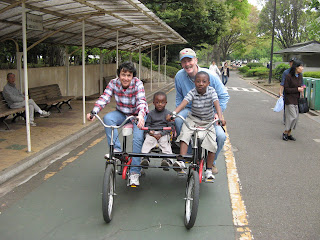but it does show Bernie and me on the slopes of Mt. Fuji recently.
It’s an amazing conundrum. When I have the most pressing deadlines, my mind is everywhere but on what I need to be thinking about most. Thus, involved as I am in two big writing projects, yet not having achieved the progress I should have by now, I’m struggling to control my mind from asking the most random questions. For example:
*How can Japan be having a “dry rainy season,” according to weather forecasters, when it’s rained nearly every day (it seems) during the month of July? Usually in the summer, our plants wilt from heat and a lack of water. This month, they’ve drowned.
*According to the newspaper, Japan’s Construction and Transport Ministry has decided to conduct a survey over the next year to judge how well railway companies are handling rush hours. With some trains running at 200% capacity, does anyone need to spend time and money on such a survey? Isn’t the answer obvious?
*And besides, is the Construction and Transport Ministry going to do anything to change the situation when they admit that trains are dangerously overcrowded in Tokyo? Hmm.
*Why did our favorite toy store in Jiyugaoka sell out and become a dog boutique? We used to take our now-adult kids there years ago. I feel like organizing a protest march. If there’s anything Jiyugaoka doesn’t need, it’s another dog boutique. We don’t have even one game and toy store now, but doggie stores are everywhere—and growing in numbers.
*Japanese are great recyclers. We have a whole closet devoted to this mandated practice: burnables, non-burnables, aluminum cans, steel cans, milk cartons, newspapers, glass, and plastic pop bottles. So why do stores over-package with such delight? Recycling would be much easier if there wasn’t so much to handle. (The salad I enjoy buying at a nearby store comes in its disposable salad bowl that is wrapped in a plastic bag, then in a paper bag, and finally is put in another plastic bag with handles for easy carrying.)
*Why does a McDonald’s hamburger taste better in Japan than in the United States, even though they are supposedly the same? Could it be because the service is so much better in Japan? And there’s no tipping expected anywhere in this country, either.
*It’s quite hot here today, but this is to be expected in summer. So why do Americans always want to live in the season it’s not? Why do they turn their air conditioners so cold that one must put on a sweater or jacket indoors in the summer? Likewise, why do they run their furnaces so hot in winter that people wear short sleeves to keep from sweating? One American once told me it was his right to sleep “naturally” and that he didn’t like the heavy weight of blankets—that’s why his furnace was set at 80 degrees. I wonder if he’s as self-centered as he seemed. Probably.
*How can I feel so much love for the sonogram picture that hangs above my desk?
*How will I ever make these deadlines if I don’t get back to work?



